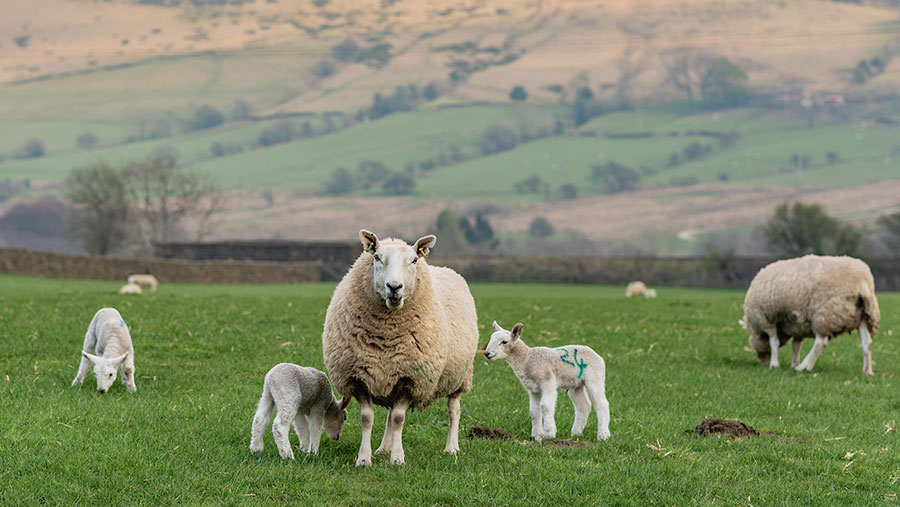Many Welsh farmers over-reliant on subsidies, survey shows
 © Szabolcs Csehak/Adobe Stock
© Szabolcs Csehak/Adobe Stock The reliance of some Welsh farming systems on government support payments and non-farming income has been laid bare in new farm income figures.
The latest Farm Business Survey shows that for upland cattle and sheep farms the Basic Payment Scheme (BPS), other subsidies, diversified incomes, and miscellaneous income such as rents and wayleaves contributed on average about 30% to their total income (outputs) and 240% of profits in 2019-20.
This was reflected in other systems, too – income for the average hill sheep farm was £263/ha compared with £532/ha for beef, sheep and crops.
See also: Guide to funding for tree projects on farm
Survey director Tony O’Regan said this threw into doubt the survival of some farms amid imminent changes to farm support structures.
“With this level of dependency, it is difficult to see how many Welsh farms with limited options for changing farming enterprises and/or system can be profitable without relying on non-farming income and government support payments,’’ he said.
Variable results
Aberystwyth University conducted the 2019-20 survey across a random sample of just over 500 Welsh farms.
The data set out in the Farm Business Survey in Wales incomes booklet confirms significant differences between average-performing farms and those in the top third for performance.
The top-third cattle and sheep farms made more than double the profit on each effective hectare compared with the average producer, while on dairy farms the top third made a net margin of 10p/litre more than the bottom third.
Meat producers showed similar variability, with lamb production ranging from making 34p/kg to losing 90p/kg and, for beef, from plus 6p/kg to minus 121p/kg.
“None of these take into account the farmer’s labour cost, the absence of which, if misused, presents a false picture of the economics of farm production,’’ said Mr Regan.
“The dairy sector best illustrates this, since labour and pension costs alone can add more than 9p/litre, which then pushes the costs of production for the top third to 30p/litre and the bottom third closer to 37p/litre.’’
Finished cattle prices had remained low throughout the year, but store cattle prices were more variable and, depending on type, prices held up better and improved towards the end of the accounting periods.
Milk prices were more volatile and lower than the previous 12 months, with significant variability between the regions, contracts, buyers and systems. However, dairy margins overall were relatively unchanged.
|
How the main sectors performed in 2019-20 |
||||||
|
|
Lowland dairy farms |
Hill and upland dairy farms |
Upland cattle and sheep farms |
Lowland cattle and sheep farms |
Hill sheep farms |
Hill cattle and sheep farms |
|
Total income/ha |
£4,142 |
£3,621 |
£1,001 |
£1,181 |
£895 |
£973 |
|
Total variable and fixed costs/ha |
£3,464 |
£3,004 |
£814 |
£904 |
£639 |
£764 |
|
Profit after rent and finance/ha |
£471 |
£426 |
£119 |
£170 |
£214 |
£146 |
|
Unpaid labour/ha |
£102 |
£125 |
£40 |
£51 |
£33 |
£62 |
Farm costs and income |
||||||
|
|
Top-third lowland dairy farms |
Top-third hill and upland dairy farms |
Top-third upland cattle and sheep farms |
Top-third lowland cattle and sheep farms |
Top-third hill sheep farms |
Top-third hill cattle and sheep farms |
|
Total income/ha |
£4,876 |
£4,249 |
£1,262 |
£1,618 |
£1,143 |
£1,126 |
|
Total variable and fixed costs/ha |
£3,455 |
£3,049 |
£844 |
£1,010 |
£723 |
£683 |
|
Profit after rent and finance/ha |
£1,263 |
£1,073 |
£341 |
£559 |
£377 |
£398 |
|
Unpaid labour/ha |
£114 |
£87 |
£45 |
£119 |
£47 |
£72 |
